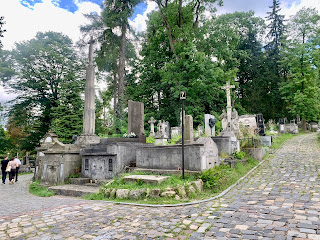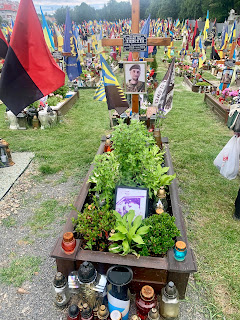29th - 30th Jul 2023
 |
| Part of the enormous Lychakivsky cemetery |
Of course the war in Ukraine is never far from people's minds here, as elsewhere. However this should be put into perspective. Don't forget that the area of 'fighting' in the country, at the eastern end, is about 500 miles from Lviv in the west. It is a vast country. Sure, there have been Russian missiles dropped on various other parts of the country, including a few on the outskirts of Lviv and one in July which hit an apartment block, but the people give no impression of being 'scared' or unduly anxious about this. This was equally true in Kyiv which I visited last year. It reminds me of the time I lived for a few years in Northern Ireland during the 'Troubles'. Bombs were regularly going off in many towns and other places, but we lived a perfectly normal and jolly social life and weren't in the least 'scared' or felt 'limited' by this situation, just careful to avoid the dodgy areas. The media, as always and increasingly, plays a large part in colouring people's opinions and perceptions and devotes their coverage to the spectacular 'bad' things while ignoring the normality of the major part of a place (vis. Covid and now 'climate change'). I was told by many "You must have been mad to go to Ukraine! It must have been very dangerous!". The answer to that was a resounding "No!". The chance of falling victim to a Russian bomb or missile dropping on you must be about a million to one, or greater. Certainly nothing alarming happened during my visit. The people here get on with life in a determinedly normal way. If anything, this conflict has drawn them closer together socially (the old 'Blitz Spirit') and they certainly don't have the inclination to bother with all the trivial 'woke' and 'politically correct' nonsense which seems to capture the attention, and furore, of our permanently 'offence-taking' and 'risk averse' British public!
As far as I am aware there has never been any damage caused in the central and historic 'old' part of the city.
Left: ....and there were signs of wounded soldiers, presumably back home recuperating.
Left: Some of the tombs had photos of the occupants 'engraved' on them and which had lasted and are visible even after 100 years.
Right: The tomb of the late Ivan Franko, one of Lviv's most eminent citizens. He was a writer, journalist, philosopher, activist etc. etc and died in 1916. The City University and a large park (and probably a street) are named after him.
Left: Adjacent to the main cemetery is this separate one. It contains the graves of all the local soldiers killed in the present (and since 2014) ongoing conflict with Russia.
Right: The graves are very well tended and most display a photo of the deceased soldier.
Left: Talking of streets, all the Lviv streets are well marked and signs are written in both Cyrillic and Roman script, which makes it somewhat easier for the Western tourist. I was rather fascinated by this one and not sure what the English-born silent film actor/comedian Charlie Chaplin's connection was with the city. Perhaps they just liked him?
On reaching the park area below the summit, I was confronted by this sign (left) which blocked the entrance to the steps up to the top. Of course, not being able to read Cyrillic writing, I disregarded it and set off up a steep winding metal stairway. It was a long way up, and there was another 'sign' and barrier blocking the way further on, again disregarded by this stupid ignorant foreign tourist. I had suspected what I would find. Sure enough, emerging at the top I came upon a camouflaged and reinforced military post with an armed guard plus guard dog. I doffed my hat politely and waved cheerfully to him. I asked if I could go on in. The answer was a sullen and firm 'Nyet'. At least he didn't shoot me and the guard dog only sniffed my trousers. I expect there was a battery of anti-missile missiles based up there. I didn't pursue the conversation and went back down.
Right: Not my photo of course, but this is an archive photo of the summit as it was before the 'you know what' situation.
Left: Back down in the park there was a decent café which served me a much needed beer.
Right: I did manage to get my own photo of the city, looking south-west through the trees, from the park.
Right: The statue of St.George and the Dragon near the main police station and Internal Security offices in the Old Town. It is dedicated to the memory of those who have died in the 'fight against crime'.
That will do for the time being!




















No comments:
Post a Comment